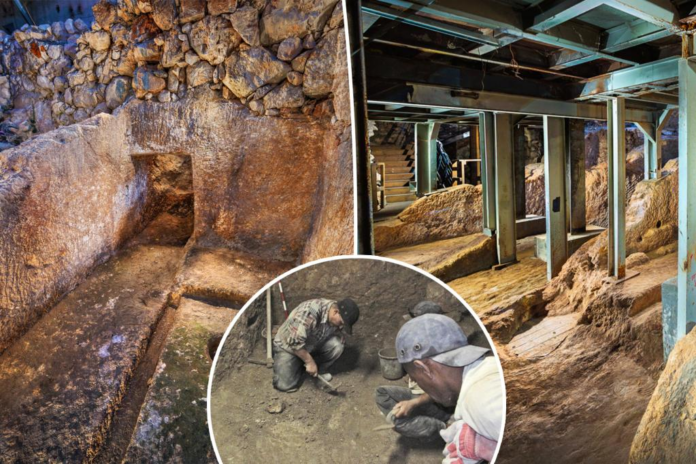A religious shrine sealed up by the ancestors of Jesus — and preserved for nearly 3,000 years — has been discovered in the ancient heart of Jerusalem.
The place of worship, carved into the rock near Temple Mount, is made up of eight rooms with an altar, a sacred standing stone, and presses for olive oil and wine.
7 Obscure v-shaped carvings were marked on the floor of one part of the site. Credit: Kobi Harati/City of David via Pen News
Experts believe that the destruction of the shrine might even be featured in the Bible in a description of how Hezekiah, an ancestor of Jesus, smashed idolatrous places of worship.
According to Eli Shukron — excavation director for the Israel Antiquities Authority (IAA), who published his findings in its in-house scientific journal, ‘Atiqot — the location is dated to Hezekiah’s reign.
7 A new structure was uncovered by the Israel Antiques Authority on the eastern slope of the City of David. VLADIMIR NAIKHIN/ISRAEL ANTIQUES AUTHORITY
“The structure ceased to function during the 8th century BC, possibly as part of King Hezekiah’s religious reform,” Shukron explained.
“According to the Bible, Hezekiah sought to centralize worship at the temple in Jerusalem, abolishing the ritual sites scattered across the kingdom. The Bible describes how, during the First Temple period, additional ritual sites operated outside the temple.
“It says two kings of Judah – Hezekiah and Josiah – implemented reforms to eliminate these sites and concentrate worship at the temple.”
Both Hezekiah and Josiah are identified as paternal grandfathers of Jesus in the Gospel of Matthew.
The second book of Kings describes Hezekiah’s suppression of pagan places of worship, or “high places.”
7 The place of worship featured presses for olive oil and wine. Credit: Kobi Harati/City of David via Pen News
It outlines how he “removed the high places, smashed the sacred stones” and “did what was right in the eyes of the Lord” — but the sacred standing stone at the site survived Hezekiah’s abolition.
Shukron called the discovery “the most dramatic and important find in the excavation.”
Though the excavations began in 2010, the northern part of the ruins was first discovered in 1909 by Montague Parker, a British adventurer searching for the Ark of the Covenant — which once contained the original 10 Commandments — and other temple treasures.
7 The second book of Kings notes Hezekiah’s suppression of pagan places of worship, or “high places.” Credit: Pen News
7 Another room had the remains of an altar, which they identified by a drainage channel that still ran from a corner. Credit: Kobi Harati/City of David via Pen News
“This is what makes this place a cultic site,” he said. “When we uncovered it, we found it standing in its place, with stones around it. The standing stone was covered with earth; it was preserved – no one destroyed it.
“When we found it, it was exactly as it was here 2,800 years ago.”
Another room in the place of worship had the remains of an altar, which they identified by a drainage channel that still ran from a corner.
7 “When we found it, it was exactly as it was here 2,800 years ago,” one researcher said. VLADIMIR NAIKHIN/ISRAEL ANTIQUES AUTHORITY
Obscure, v-shaped carvings were marked on the floor of one part of the site, and though the true reason behind them is lost to history, it’s suspected that they might have supported some type of ritual tripod, Pen News reported.
Artifacts from the 8th century BC were also found sealed behind a stone wall in a cave. The archaeologists uncovered cooking pots, jars with ancient Hebrew inscriptions, loom weights, scarabs, stamped seals with decorative motifs and grinding stones.
7 An illustration of the ruins. Credit: Shalom Kveller/City of David via Pen News
“This unique structure uncovered in the City of David is an exciting testimony to Jerusalem’s rich past,” said Amichai Eliyahu, Israel’s Minister of Heritage.
“Such discoveries make our connection and historic roots – going back thousands of years – tangible, in Jerusalem and other sites where the Jewish culture and belief system emerged.”


